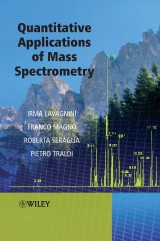Details

Quantitative Applications of Mass Spectrometry
1. Aufl.
|
45,99 € |
|
| Verlag: | Wiley |
| Format: | |
| Veröffentl.: | 01.05.2006 |
| ISBN/EAN: | 9780470025185 |
| Sprache: | englisch |
| Anzahl Seiten: | 152 |
DRM-geschütztes eBook, Sie benötigen z.B. Adobe Digital Editions und eine Adobe ID zum Lesen.
Beschreibungen
This text presents the information needed to design a successful quantitative analysis using mass spectrometric techniques currently available and widely employed. It is devoted to the researchers of different areas, who use mass spectrometry as a detector suitable for the measurements of their interest. <ul> <li>An essential book for the practicing mass spectroscopist</li> <li>A genuine 'how-to' text for the practitioner focusing on quantification rather than instrumental design and techniques</li> <li>Up-to-date structured text describing methods, experimental strategy, capabilities and limitations, with data analysis and interpretation</li> <li>Brings together material widely dispersed in the pertinent literature into one unique source</li> <li>Internationally recognized group of authors</li> </ul>
Preface. <p>Acknowledgements.</p> <p>Introduction.</p> <p><b>1 What Instrumental Approaches are Available.</b></p> <p>1.1 Ion Sources.</p> <p>1.1.1 Electron Ionization.</p> <p>1.1.2 Chemical Ionization.</p> <p>1.1.3 Atmospheric Pressure Chemical Ionization.</p> <p>1.1.4 Electrospray Ionization.</p> <p>1.1.5 Atmospheric Pressure Photoionization.</p> <p>1.1.6 Matrix-assisted Laser Desorption/Ionization.</p> <p>1.2 Mass Analysers.</p> <p>1.2.1 Mass Resolution.</p> <p>1.2.2 Sector Analysers.</p> <p>1.2.3 Quadrupole Analysers.</p> <p>1.2.4 Time-of-flight.</p> <p>1.3 GC/MS.</p> <p>1.3.1 Total Ion Current (TIC) Chromatogram.</p> <p>1.3.2 Reconstructed Ion Chromatogram (RIC).</p> <p>1.3.3 Multiple Ion Detection (MID).</p> <p>1.4 LC/MS.</p> <p>1.5 MS/MS.</p> <p>1.5.1 MS/MS by Double Focusing Instruments.</p> <p>1.5.2 MS/MS by Triple Quadrupoles.</p> <p>1.5.3 MS/MS by Ion Traps.</p> <p>1.5.4 MS/MS by Q-TOF.</p> <p>References.</p> <p><b>2 How to Design a Quantitative Analysis.</b></p> <p>2.1 General Strategy.</p> <p>2.1.1 Project.</p> <p>2.1.2 Sampling.</p> <p>2.1.3 Sample Treatment.</p> <p>2.1.4 Instrumental Analysis.</p> <p>2.1.5 Method Validation.</p> <p>References.</p> <p><b>3 How to Improve Specificity.</b></p> <p>3.1 Choice of a Suitable Chromatographic Procedure.</p> <p>3.1.1 GC/MS Measurements in Low and High Resolution Conditions.</p> <p>3.1.2 LC/ESI/MS and LC/APCI/MS Measurements.</p> <p>3.2 Choice of a Suitable Ionization Method.</p> <p>3.3 An Example of High Specificity and Selectivity Methods: The Dioxin Analysis.</p> <p>3.3.1 Use of High Resolution MID Analysis.</p> <p>3.3.2 NICI in the Analysis of Dioxins, Furans and PCBs.</p> <p>3.3.3 MS/MS in the Detection of Dioxins, Furans and PCBs.</p> <p>3.4 An Example of MALDI/MS in Quantitative Analysis of Polypeptides: Substance P.</p> <p>References.</p> <p><b>4 Some Thoughts on Calibration and Data Analysis.</b></p> <p>4.1 Calibration Designs.</p> <p>4.2 Homoscedastic and Heteroscedastic Data.</p> <p>4.2.1 Variance Model.</p> <p>4.3 Calibration Models.</p> <p>4.3.1 Unweighted Regression.</p> <p>4.3.2 Weighted Regression.</p> <p>4.3.3 A Practical Example.</p> <p>4.4 Different Approaches to Estimate Detection and Quantification Limits.</p> <p>References.</p> <p><b>Index.</b></p>
"…anyone needing to do serious quantitative work using GC/MS could learn from these authors." (<i>CHOICE</i>, January 2007)
<b>Professor Pietro Traldi</b>, Research Executive, National Council of Research, CNR, ISTM Corso Stati Uniti 4 I35127 Padova, Italy <p>Fields of interest include structure and reactivity of gaseous ions; -MS application in environmental and biomedical fields; Development of new analytical methods; Instrumental developments. Pietro Traldi is author of over 500 publications on international journals; he is member of the advisory boards of JMS, MSR, RCM and EMS. He is the promoter and the chairman of the Informal Meeting of Mass Spectrometry.</p> <p><b>Professor Irma Lavagnini,</b> Associate Professor in Analytical Chemistry, Faculty of Pharmacy. Scientific research focus is Chemical data handling</p> <p><b>Professor Franco Magno,</b> Padua University, Italy, Full Professor of Analytical Chemistry since 1980. Main research areas in electroanalytical techniques; Development and application of the digital simulation techniques to rationalize voltammetric responses; Development and optimization of analytical procedures to determine species of relevant enviromental and/or industrial interest.<i><br /> <br /> </i><b>Dr Roberta Seraglia,</b> National Council of Research, Padova, Italy, Researcher of CNR, Institute of Molecular Sciences and Technologies, Padova. 130 papers published in International Journals and 160 communications at International and National congresses.</p>
What is usually required of an analytical technique? Specificity, selectivity and sensitivity -or, more precisely, a detection limit as low as possible. These criteria are fulfilled by mass spectrometry is an essential tool for qualitative and quantitative investigations in many applications, in particular in environmental science and biomedicine,with positive benefits to mankind. <p>The problem that has arisen from this large expansion is that mass spectrometry is mainly considered as a "magic box" technique, in which on one side a sample is introduced and on the other side the analytical data comes out. Thus, the basic aspects of the technique are often not well known. To overcome this, the authors present within this text some basic information for scientists and technicians working in the field of quantitative organic mass spectrometry, in particular for those who, for the first time, face all the problems arising from the development and use of a quantitative procedure.</p> <p>This informative text presents basic information on:</p> <ul> <li> <div>What instrumental approaches are available</div> </li> <li> <div>How to design a quantitative analysis</div> </li> <li> <div>How to improve specificity</div> </li> <li> <div>Some thoughts on calibration and data analysis</div> </li> </ul> <p>This book is mainly aimed at analytical chemists working in academic, environmental, pharmaceutical, biochemical, forensic, clinical and industrial laboratories, but is also appropriate for researchers new to the technique, e.g. biochemists, biologist, physicians and workers in pharmaceutical, food and the health sciences.</p>


















